Mental handicap
In 1868 Dr John Langdon Down, together with his wife Mary, established a private Asylum for mentally handicapped children from upper class families and those of 'good social position', i.e. bankers, doctors, clergymen and senior army officers. The Langdon Downs felt that these children were in some ways more deprived than others, being hidden away from society.
The Langdon Downs purchased The White House, a large family mansion with 5 acres of grounds in Kingston Road, Teddington, near to Hampton Wick. The house had been built two years previously but had never been occupied. The Langdon Downs renamed it Normansfield, in honour of their solicitor, Norman Wilkinson, who had helped and advised them about mortgage facilities.
The Normansfield Training Institution for Imbeciles opened in May 1868. By the end of the year there were 19 patients, some of whom had been at the Asylum for Idiots at Earlswood, where Dr Langdon Down had been appointed Medical Superintendent in 1858.
The patients varied in age from toddlers to adults, with twice as many boys as girls. Not all were mentally handicapped; some had physical disabilities, such as blindness or cerebral palsy. Some 60% had epilepsy and were treated with bromide, with some success. It was the Langdon Downs' intention to educate and train the patients according to their capabilities, Each would be taught 'life skills' - dressing, feeding, cooking, how to use money when buying or selling, and how to weigh and measure things. They also received instruction from several teachers in 'kindergarten', music, dancing and languages. Daily exercise included drill, gymnastics, roller-skating, riding, cycling, cricket, tennis, football, swimming and boating. The older patients learned trade skills and made handicrafts.
Normansfield soon had to be expanded. A south wing was added in 1869 and a north wing in 1873, after which the Institution could accommodate 57 patients. However, still more room was needed and two adjoining properties were purchased, together with more land, including a field running down to the river Thames on the far side of the lower road.
In 1877 farm buildings were built. Work on the farm and in the kitchen garden provided occupation for the patients and made the Institution increasingly self-sufficient. The farm bred pigs, and the Normansfield Large Whites became well known and won many prizes. Cows and chickens provided dairy products and eggs, while the kitchen garden provided home-grown produce.In the same year work began on the erection of an Entertainment Hall. Normansfield had been renamed as an Institution for the feeble-minded, with an annual charge of £200 per patient, a huge sum of money then.
In 1878, when there were 106 patients, Broom Hall was purchased to provide extra accommodation (it was later renamed The Conifers).
The Normansfield Institution was registered in the name of Mary Langdon Down, while Dr Langdon Down was the Medical Superintendent (by law such institutions with more than 100 residents were required to have a resident Medical Superintendent). Dr Langdon Down continued his medical practice at 81 Harley Street, as well as acting as honorary consultant physician to the London Hospital in Whitechapel.
Mary Langdon Down, an able and practical woman known as 'Little Mother', supervised the day-to-day running of the Institutition.
In June 1879 the lavish Entertainment Hall, which had cost £3,678, was officially opened by the Earl of Devon. Plays and pantomimes were staged by the staff, many of whom had been engaged because they could sing, act or play a muscial instrument. These entertainments were greatly anticipated and sometimes the patients participated. On Sundays the Hall was used for services, with patients and staff providing the choir. At Christmas there was a special pantomine, and Christmas dinner would be followed by dancing.
As Normansfield became well known, more accommodation was needed. By 1888 all the land and properties between Normansfield Road and Holmesdale Road, and between Kingston Road and Broom Road, had been acquired by the Asylum - a total of 40 acres.
In 1882 Eastcote was bought and renamed Trematon. A laundry was built in 1883, and a boathouse in 1884 (rowing became a family tradition). A drill hall was built in the grounds of Trematon in 1889. A clock tower was built during 1891-92, by which time there were 150 patients.
In October1896 Dr Langdon Down died suddenly of a heart attack at the age of 67 years. Mary Langdon Down died four years later, in October 1900. Their two sons, both medically qualified, took over the running of the Institution.
Imprisonment and teasing of the patients were forbidden; the only acceptable pubishment was the displeasure of a loved carer, with the threat of a temporary withdrawl of affection. In 1901 an attendant was fined 40 shillings (£2) at Teddington Police Court for assaulting a patient by kicking him three times in the stomach and striking him repeatedly. The nursing press considered this far too lenient for such brutality and declared imprisonment with hard labour would have been preferable.
Percival was very interested in amateur dramatics and a local club was founded which continued to meet in the Entertainment Hall until the beginning of WW1. (The Entertainment Hall never opened again as a theatre after the war, but it continued to be used for services, staff dances and fund-raising activities; it remained remarkably well-preserved.)
The Asylum by now was divided into four parts: one wing was for women and children, and one wing for men and boys, while higher-grade women were accommodated in Conifers and higher-grade men in Trematon. Each group had its own section of the garden and parkland.
Excursions to the seaside were also provided. During the school holidays a school on the south coast was rented for six weeks, so that most of the patients had a holiday. At first, this had entailed a special train to convey trunk loads of bed linen, clothing and crockery, but later coaches were used. (The seaside holidays continued up to the outbreak of WW2 in 1939).
In 1913 the main building became a Certified House under the Mental Deficiency Act of that year, with the North Wing accommodating male patients and the South Wing women and children. There were no wards, just rooms, and each nurse slept in the same room as her patients. Conifers and Trematon became Approved Homes.
During WW1 the Asylum experienced difficulties due to staff shortages, as did all hospitals, caused by enlistment of staff to the Armed Forces and Nursing Corps.
In 1917 Jane Langdon Down died, and Percival's wife Helen took over management of the institution. After the war, wages and the cost of maintenance had risen, as had the running expenses, and the in-patient fees had to be increased.
In 1925 Percival died, and the Asylum became a limited company, with Reginald Langdon Down and Helen, Percival's widow, as its directors. The Asylum became known simply as Normansfield, and was advertised as "a training home for the feeble-minded". Trematon became a school home for boys and Conifers one for girls.
Staff shortages occurred again during WW2 and, in 1940, Reginald's daughter Stella, who had married the neurologist Dr Russell Brain (later Lord Brain), moved to Teddington with her family to help her father and Helen (now both over 70 years of age) with the running of the asylum.
The location of Normansfield, near to the National Physical Laboratory in Teddington, Teddington Lock and Richmond Park (where fires burned to make enemy pilots think they were over London) made it vunerable to bombing. Air-raid shelters were built, but proved unsuitable. The 160 patients were moved to dormitories in the semi-basements of the North and South Wings. Several high explosive and incendiary bombs fell in the grounds of the estate, damaging buildings but causing no casualties. However, in June 1944 Conifers was badly damaged by a V1 rocket and one patient was killed. All the windows of the main building were shattered, and had to be boarded up for several months until they could be reglazed. The 21 girls living at Conifers were transferred back to Normansfield.
In 1946 Percival's son, Norman, became Deputy Medical Superintendent. With the establishment of the NHS in 1948, the problems of running a private hospital became overwhelming and, following successful negotiations, Normansfield joined the NHS in June 1951 under the auspices of the South West Metropolitan Regional Hospital Board. Control of the hospital passed to the Staines Group Hospital Management Committee. Many of the higher-grade patients left, while some patients were moved to other institutions and some staff retired, but Reginald Langdon Down continued as the Medical Superintendent. (His daughter Stella (now Lady Brain) was appointed to the Management Committee in 1952.)In 1951 Normansfield was classified as a Certified Institution (until 1959, when the Mental Health Act was passed). Conifers and Trematon ceased to be Approved Homes. Most of the land belonging to the Hospital was sold (the farm had closed in 1943 because of the lack of staff).
Gradually during the 1950s the buildings were repaired, rewired and improved. In 1960 new day rooms were built and an old farm building converted into an industrial unit. A central heating system was installed in the main buildings. In 1969 two new wards and an apartment block for staff accommodation were built. Staff then ceased to sleep in the same rooms as their patients.
In 1970, when the hospital had 227 beds and 100 full-time carers, Dr Norman Langdon Down retired, bringing to an end the family connection with Normansfield. He was replaced by a consultant psychiatrist, Dr Terence Lawlor.
In 1971 responsibility for education of children in hospitals passed to local authorities. The London Borough of Richmond on Thames took over the schooling of the children at Normansfield. A few children attended special schools and, in 1974, the Normansfield Education Unit transferred to Trematon.
In 1974, following a reorganisation of the NHS, Normansfield came under the control of the Kingston and Richmond Area Health Authority, part of the South West Thames Regional Health Authority. By this time it had become a 'problem hospital'.
Dr Lawlor, described variously as "incompetent", "arrogant" and "an authoritarian", had soured relationships with his medical colleagues and most of the nursing staff. Senior staff resigned and there was increasing difficulty in recruiting and retaining good staff. The buildings had become run-down and were in a state of disrepair, while internally the rooms were filthy and the furnishings damaged, making it difficult to provide proper care. Patients lacked adequate physiotherapy, speech therapy, dental care and occupational therapy. On May 1976 most of the nursing staff went on strike, leaving the patients without adequate care and demanding the suspension of Dr Lawlor. The Regional Health Authority, in order to resolve the strike, suspended Dr Lawlor and ordered an inquiry into the circumstances leading to the strike. The inquiry opened in November, sitting in private, but was adjourned six days later 'sine die' (indefinitely) owing to the withdrawal of Dr Lawlor and the medical member of the panel. A new Committee of Inquiry was appointed by the Secretary of State for Social Services, which gave the committee power to receive evidence on oath and to compel the attendance of witnesses. The proceedings, which began in February 1977, were held in public and lasted until February 1978. The Committee's report, published the following November, found that very few concerned with the management of the Hospital were without blame. It recommended that Dr Lawlor's contract be terminated and that several nursing officers and administrators be dismissed. (Dr Lawlor apparently moved to Australia and continued to practise as a psychiatrist).
A decision to close the Hospital was made during the 1980s when it was under the control
of the Richmond, Twickenham and Roehampton Healthcare NHS Trust.
It closed in 1997.
Present status (May 2008)
The 32-acre site was bought by Laing Homes in 1999, who redeveloped it as Langdon Park, a housing estate of some 190 homes.
The original Hospital building survives and is Grade II*-listed. Plans were made to convert it into a 49-bed hotel with restaurant, but these have not yet materialised.
The Grade II*-listed Entertainment Hall has been restored and, with the northern wing of the Hospital building, forms the Langdon Down Centre. The Centre contains a workshop theatre museum, cafe and meeting rooms for use by the Down's Syndrome Association and other learning disability groups, and local arts organisations. It is intended to establish a museum dedicated to the history of Normansfield; it would also contain the historical archives of Dr Langdon Down.
The Hospital workshops and mortuary are Grade II-listed. The boundary wall with Kingston Road retains its original cast-iron railings.
The remainder of the buildings, including Trematon and The Conifers have been demolished.
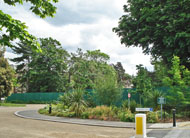
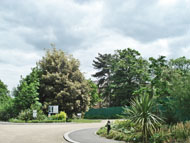
Glimpses of the house from the northwest in Langdon Park.
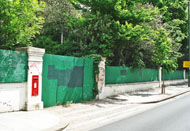
The old entrance with its gate piers in Kingston Road.
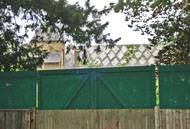
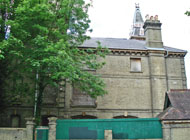
The hospital buildings as seen from Normansfield Road.
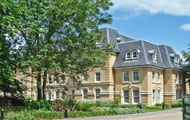
New housing at the north of the site.
His first grandson, born in 1905, seven years after his death, had the condition.
In 1959 a French paediatrician and geneticist, Prof Jerome Lejeune, proved mongolism to be caused by a chromosomal abnormality - instead of the usual 46 chromosomes present in each cell, there were 47 (three copies of the 21st chromosome instead of two; hence the scientific name 'trisomy 21').
In 1961 Dr Norman Langdon Down, together with a group of international experts in mental disability, wrote to The Lancet suggesting that the term 'Mongolian idiot' had become an embarrassing term with misleading connotations and should be changed to 'Langdon Down anomaly', 'Down's syndrome' (or 'anomaly') or 'congenital acromicria'. The Lancet supported 'Down's syndrome', but nothing came of this suggestion until 1965, when the World Health Organization, at the request of the Mongolian government, agreed to the new name.
Down JLH 1866 Observations on an ethnic classification of idiots. London Hospital Reports 3, 259-262.
(Author unstated) 1901 A brutal attendant. Nursing Record and Hospital World, 16th March, 208.
(Author unstated) 1978 The Normansfield Inquiry. British Medical Journal 2 (6151), 1560-1563.
Brain S (undated) Normansfield.
Chaplin R, Peters S 2003 Executives have taken over the asylum: the fate of 71 psychiatric hospitals. Psychiatric Bulletin 27, 227-229.
Merriman A 2007 Tales of Normansfield. Teddington, Down's Syndrome Association.
http://e-voice.org.uk
http://londonist.com
http://pb.rcpsych.org
http://urbandesertion.squarespace.com
www.28dayslater.co.uk
www.aim25.ac.uk
www.bbc.co.uk
www.cunnanetownplanning.co.uk
www.dereliction.fpic.co.uk
www.guerillaphotography.fotopic.net
www.langdondowncentre.org.uk
www.miriam-may.com
www.nationalarchives.gov.uk
www.opacity.us
www.richmond.gov.uk
www.twickenham-museum.org.uk
www.studymore.org.uk
www.twickenham-museum.org.uk
Return to home page